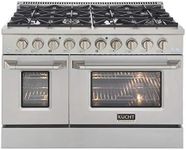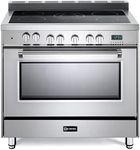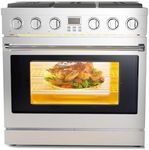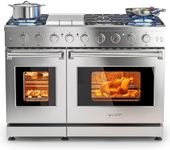Buying Guide for the Best Freestanding Oven
Choosing the right freestanding oven can significantly enhance your cooking experience. A freestanding oven combines both an oven and a cooktop in one unit, making it a versatile and space-saving option for your kitchen. When selecting a freestanding oven, it's important to consider various specifications to ensure it meets your cooking needs and fits well in your kitchen space. Here are some key specifications to consider and how to navigate them to find the best fit for you.Size and CapacityThe size and capacity of a freestanding oven are crucial as they determine how much food you can cook at once and whether the unit will fit in your kitchen. Sizes typically range from 20 to 36 inches in width. Smaller ovens (20-24 inches) are suitable for compact kitchens or smaller households, while larger ovens (30-36 inches) are ideal for bigger families or those who frequently entertain guests. Consider the available space in your kitchen and your cooking habits when choosing the size and capacity.
Fuel TypeFreestanding ovens can be powered by gas, electricity, or dual fuel (a combination of both). Gas ovens offer precise temperature control and are often preferred by professional chefs. Electric ovens provide even heating and are easier to install. Dual fuel ovens combine the benefits of both gas cooktops and electric ovens, offering versatility. Your choice should depend on your cooking preferences and the existing utility connections in your kitchen.
Cooktop ConfigurationThe cooktop configuration refers to the number and type of burners or heating elements on the cooktop. Common configurations include four, five, or six burners. Some cooktops also feature specialized burners, such as high-heat burners for boiling and simmer burners for delicate tasks. If you frequently cook multiple dishes at once, a cooktop with more burners or specialized options may be beneficial. Consider your cooking style and the types of dishes you prepare when selecting a cooktop configuration.
Oven FeaturesModern freestanding ovens come with a variety of features that can enhance your cooking experience. Convection ovens use a fan to circulate hot air, resulting in faster and more even cooking. Self-cleaning ovens save time and effort by using high heat to burn off food residue. Other features to consider include programmable timers, temperature probes, and multiple cooking modes (such as bake, broil, and roast). Think about which features will be most useful for your cooking needs and lifestyle.
Energy EfficiencyEnergy efficiency is an important consideration as it affects both your utility bills and the environment. Look for ovens with an Energy Star rating or other energy-efficient certifications. These models use less energy while still providing excellent cooking performance. If you cook frequently, an energy-efficient oven can lead to significant savings over time. Consider your cooking frequency and environmental impact when evaluating energy efficiency.
Build Quality and DesignThe build quality and design of a freestanding oven can impact its durability and how well it fits with your kitchen decor. Stainless steel models are popular for their sleek appearance and resistance to rust and stains. Look for ovens with sturdy construction, smooth finishes, and easy-to-clean surfaces. The design should also complement your kitchen's style, whether it's modern, traditional, or somewhere in between. Consider both aesthetics and durability when choosing the build quality and design.




















